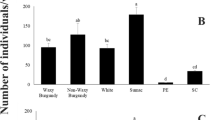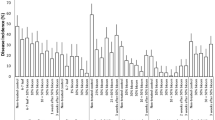Abstract
The effect of male to female row ratios and fungicide application at several panicle development stages to control sorghum ergot, under field conditions and natural infection was studied at Texcoco, State of México. A pair of isogenic sorghum lines (A9/B9) was sown in May 3 and June 10, 2005; and in April 3, 2006. Two male to female row ratios (M:F = 2:4, 2:6) were used in 2005, and 2:8 and 2:12 in 2006. Propiconazole (Tilt®) was sprayed on the female rows at a rate of 250 g a.i. ha−1 from panicle emergence to the end of flowering, with one, two and three applications. Pollen viability was quantified in the B9-line. Seed yield per hectare, seed production per panicle, disease incidence and severity, number of sclerotia per panicle, seeds contaminated by honeydew per panicle, and seed germination were registered in the A9-line. Pollen viability varied from 76 to 89 % among sowing dates despite the fact that at microsporogenesis, mean minimum temperature was below 9.2 °C. Fungicide application accounted for 49 % of the observed variance. The greatest seed yield (2,358 kg ha−1) was obtained in 2006, which surpassed by 195 kg ha−1 the mean value of the dates sown in 2005. Disease incidence and severity were significantly greater in the 2006 trial than at both planting dates in 2005. In contrast, sowing dates showed small differences in seed production per panicle and seed germination. Fungicide treatment with three applications produced a better ergot control than treatments with one or two applications.
Similar content being viewed by others
References
Aguirre RJ, Williams AH, Montes GN, Cortinas-Escobar HM (1997) First report of sorghum ergot caused by Sphacelia sorghi in México. Plant Dis 81:831
Bandyopadhyay R, Frederickson DE, McLaren NW, Odvody GN, Ryley MJ (1998) Ergot: a new disease threat to sorghum, in the Americas and Australia. Plant Dis 82:356–367
Chakraborty S, Ryley MJ (2008) Sorghum ergot can develop with local Claviceps africana from infected plants. Plant Pathol 57:473–483
Cisneros-López ME, Mendoza-Onofre LE, Zavaleta-Mancera HA, González-Hernández VA, Córdova-Téllez L, Hernández-Martínez M, Mora-Aguilera G (2009) Floral traits and seed production of sorghum A-, B-, and R- lines under chilling field temperatures. J Agron Crop Sci 195:464–471
Cisneros-López ME, Mendoza-Onofre LE, González-Hernández VA, Mora-Aguilera G, Hernández-Martínez M, Zavaleta-Mancera HA, Córdova-Téllez L (2010) Floral traits, ergot resistance and grain yield relationships in infected male-sterile sorghum A-lines. Seed Sci Technol 38:123–133
Dahlberg JA, Peterson GL, Odvody GN, Bonde M (1999) Inhibition of germination and sporulation of Claviceps africana from honeydew encrusted sorghum with seed treatment fungicides. Crop Prot 18:235–238
Eastin JD, Hultquist JH, Sullivan CY (1973) Physiological maturity in grain sorghum. Crop Sci 13:175–178
Frederiksen RA, Odvody GN (2000) Compendium of sorghum diseases, 2nd edn. APS, St. Paul (Minn)
Frederiksen RA, Odvody GN (2003) Inhibition of germination of sphacelial of Claviceps africana following treatment of seed-sphacelial admixtures with captan. Crop Prot 22:95–98
Hernández-Martínez M, Mendoza-Onofre LE, Ramírez-Vallejo P, Osada-Kawasoe S, Cárdenas-Soriano E, Zavala-García F (2002) Response of sorghum B y R lines to ergot (Claviceps africana) at Celaya, Guanajuato, Mexico. In: Leslie JF (ed) Sorghum and millets diseases. Blackwell Publishing Company, Ames Iowa, pp 83–85
Hernández-Martínez M, Mendoza-Onofre LE, Ramírez Vallejo P, Cárdenas-Soriano E (2006) Incidence and severity of ergot (Claviceps africana Frederickson, Mantle and de Milliano) in two male-sterile sorghum lines as a function of distance from pollen source and its impact on seed production and quality. Seed Sci Technol 34:393–402
Isakeit T, Odvody GN, Shelby RA (1998) First report of sorghum ergot caused by Claviceps africana in the United States. Plant Dis 82:592
ISTA (1999) International seed testing association. International rules for seed testing, Zurich
León-Velasco H, Mendoza-Onofre LE, Castillo-González F, Cervantes-Santana T, Martínez-Garza A (2009) Evaluation of two generations of sorghum hybrids and parental lines. I: genetic variability and adaptability. Agrociencia 43:483–496
McLaren NW (1997) Changes in pollen viability and concomitant increase in the incidence of sorghum ergot with flowering date and implications in selection for escape resistance. J Phytopathol 145:261–265
McLaren NW, Wehner FC (1990) Relationship between climatic variables during early flowering of sorghum and the incidence of sugary caused by Sphacelia sorghi. J Phytopathol 130:82–88
McLaren NW, Saayman J, Benade J, Van der Walt M (2002) Evaluation of reduced sorghum germination. In: Leslie JF (ed) Sorghum and millets diseases. Blackwell Publishing Company, Ames Iowa, pp 267–268
Meinke H, Ryley N (1997) Effects of sorghum ergot on grain sorghum production: a preliminary climatic analysis. Aust J Agric Res 48:1241–1247
Mendoza-Onofre LE, Hernández-Martínez M, Cárdenas-Soriano E, Ramírez-Vallejo P (2006) Cold-tolerant sorghum germplasm as a potential source to ergot (Claviceps africana Frederickson, Mantle & de Milliano) tolerance. Agrociencia 40:593–603
Montes N, Odvody GN, Williams-Alanis H (2002) Advances in Claviceps africana chemical control. In: Leslie JF (ed) Sorghum and millets diseases. Blackwell Publishing Company, Ames Iowa, pp 105–110
Montes-Belmont R, Méndez-Ramírez I, Flores-Moctezuma E (2002) Relationship between sorghum ergot, sowing dates and climatic variables in Morelos, México. Crop Prot 21:899–905
Montes-García N, Williams-Alanis H, Odvody GN, Prom LK (2005) Comparative efficacy of triazole fungicides for control of Claviceps africana Frederickson, Mantle and de Milliano in sorghum [(Sorghum bicolor (L.) Moench] seed production of north Mexico. Rev Fitopatol Mex 23:152–156
Montes-García N, Prom LK, Williams-Alanis H, Isakeit T (2009) Effect of temperature and relative humidity on sorghum ergot development in northern México. Australas Plant Pathol 38:632–637
Odvody GN (2002) Recommendation from the ergot working group at the third global conference on sorghum and millets diseases. In: Leslie JF (ed) Sorghum and millets diseases. Blackwell Publishing Company, Ames Iowa, pp 73–74
Parh DK, Jordan DR, Aitken EAB, Gogel BJ, McIntyre CL, Godwin ID (2006) Genetic components of variance and role of pollen traits in sorghum ergot resistance. Crop Sci 46:2387–2395
Pfender WF (2006) Interaction of fungicide physical modes of action and plant phenology in control of stem rust of perennial ryegrass grown for seed. Plant Dis 90:1225–1232
Prom LK, Isakeit T (2003) Laboratory, greenhouse, and field assessment of fourteen fungicides for activity against Claviceps africana, causal agent of sorghum ergot. Plant Dis 87:252–258
Reed JD, Ramundo BA, Claflin LE, Tuinstra MR (2002) Analysis of resistance to ergot in sorghum and potential alternate hosts. Crop Sci 42:1135–1138
Robinson RG (1984) Distance from pollen source and yields of male sterile sunflower and sorghum. Can J Plant Sci 64:857–861
Ryley MJ (2005) Pollen release in Australian commercial grain sorghum hybrid cultivar, MR Buster. Int Sorghum Millets Newsl 46:25–28
Ryley MJ, Chakraborty S (2008) Patterns of release of secondary conidia of Claviceps africana, the sorghum ergot pathogen in Australia. Plant Pathol 57:473–483
Ryley M, Bhuiyan S, Herde D, Gordan B (2003) Efficacy timing and method of application of fungicides for management of sorghum ergot caused by Claviceps africana. Australas Plant Pathol 32:329–338
SAS Institute (2002) SAS/SAT. Ver. 9.1. SAS Institute, Cary
Schultz TR, Johnston WJ, Golob CT, Maguire JD (1993) Control of ergot in Kentucky seed production using fungicides. Plant Dis 77:685–687
Wang E, Meinke H, Ryley M, Herde D, Henzell R (2000) On the relation between weather variables and sorghum ergot infection. Aust J Agric Res 51:313–324
Wegulo SN, Martison CA, Rivera-C JM, Nutter FW (1997) Model for economic analysis of fungicide usage in hybrid corn seed production. Plant Dis 81:415–422
Wood AW, Tan DKY, Mamun EA, Sutton BG (2006) Sorghum can compensate for chilling-induced grain loss. J Agron Crop Sci 192:445–451
Workneh F, Rush CM (2002) Evaluation of relationships between weather patterns and prevalence of sorghum ergot in Texas Panhandle. Phytopathology 92:659–666
Workneh F, Narasimhan B, Srinivasan R, Rush CM (2006) Assessment of regional site-specific sorghum ergot severity potential using radar-rainfall measurement. Plant Dis 90:704–706
Acknowledgments
The authors gratefully acknowledge the scholarship granted to the first author by the National Council of Science and Technology of México (CONACYT).
Author information
Authors and Affiliations
Corresponding author
Rights and permissions
About this article
Cite this article
Cisneros-López, M.E., Mendoza-Onofre, L.E., González-Hernández, V.E. et al. Male to female row ratio and fungicide application during panicle development to control sorghum ergot in the Mexican Highlands. Australasian Plant Pathol. 41, 389–396 (2012). https://doi.org/10.1007/s13313-012-0138-2
Received:
Accepted:
Published:
Issue Date:
DOI: https://doi.org/10.1007/s13313-012-0138-2




